Music and Dance Traditions – French-Canadian Music, Song & Dance
In the mid-to late 1800s, people of French descent began moving into New Hampshire from Canada. Some were from Québec and others were from eastern Canada, an area called Acadia that was settled in the early 1600s. Most of the French-speaking people who came to New Hampshire left subsistence farms to look for work and a better life for their families.
Some people went to work in the rugged lumber camps of the north and others found more mechanized work in the mill towns of the south. Wherever they settled, French-Canadians brought their language, their strong work ethic, and love of music. Many musicians of French-Canadian descent recall the fun of soirées (house parties) when they were growing up, with fiddles and songs filling the air into the late night and early morning hours.
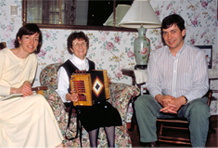
Fabienne Cote (center)
with her son Alan and
daughter Anne.
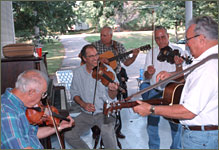
New Hampshire fiddlers
playing at a soiree
in Londonderry.
The fiddle, accordion, and guitar are the most common instruments used in French-Canadian music. The playing style is spirited and based upon rhythmic patterns of the Celtic world-jigs, reels, and waltzes. The bowing style (the way the bow is drawn across the strings) has a distinctive swing in French-Canadian music. Subtle differences exist in the bowing styles and the way tunes are ornamented (the notes that decorate the main melody) between Acadian and Québécois styles of fiddling.
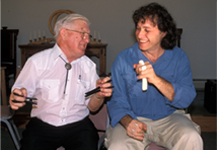
Shortey Boulet of Whitefield, NH
enjoying an exchange with
Québec musician
from the group Matapat.
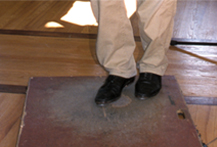
Clogging to a dance tune.
Sometimes wooden or metal spoons are knocked together to create a percussion accompaniment to the music. A style of dancing, called clogging, is done with lively skipping, stepping, and tapping movements, often with the dancer wearing leather soled shoes and dancing on a board or hard floor to the rhythm of the music. Some fiddlers can even clog while playing a tune.
Singing in the French language with family and friends is also an important part of French-Canadian musical heritage. Many French-Canadian songs are in a musical style called "chansons' répondre" (response songs). In this style, a song leader sings a line and it is repeated by the rest of the singers. This style allows a large group to join in the fun without knowing all the words of the song.
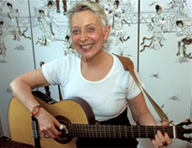
Lucie Therrien of Portmouth, NH
makes her profession
out of singing
French-Canadian and
French songs.
In 1937, a meeting of the French Language Congress was held in Québec City. They emphasized the value of song as a way to preserve culture and language. In response to this, Father Charles-Emile Gadbois from St-Hyacinthe, Québec, began a publishing company focused on printing song books.
Father Gadbois published eleven song books containing 550 French and French-Canadian songs in a collection called "La Bon Chanson" (The Good Songs). These books are still popular with many French-Canadian families, both in Canada and in New Hampshire.
For more information on French-Canadian traditions, visit The Canadian Encyclopedia.
Photo credit: Lynn Martin Graton
New Hampshire State Council on the Arts
19 Pillsbury Street - 1st Floor, Concord, NH 03301


